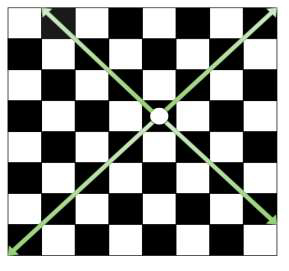
 Data Structure
Data Structure Networking
Networking RDBMS
RDBMS Operating System
Operating System Java
Java MS Excel
MS Excel iOS
iOS HTML
HTML CSS
CSS Android
Android Python
Python C Programming
C Programming C++
C++ C#
C# MongoDB
MongoDB MySQL
MySQL Javascript
Javascript PHP
PHP
- Selected Reading
- UPSC IAS Exams Notes
- Developer's Best Practices
- Questions and Answers
- Effective Resume Writing
- HR Interview Questions
- Computer Glossary
- Who is Who
Count the total number of squares that can be visited by Bishop in one move in C++
On a chessboard represented as 8 X 8 grid we are given the position of Bishop in form of row and column position. The goal is to find the total number of squares that Bishop can visit in one move. We know the Bishop can move in all directions (diagonally left up/down and right up/down).

For Example
Input
row = 5, column = 4
Output
Count of total number of squares that can be visited by Bishop in one move are: 13
Explanation
As shown in above figure the squares that Bishop can cover are 9.
Input
row = 1, column = 1
Output
Count of total number of squares that can be visited by Bishop in one move are: 7
Explanation
As this is the corner most position, then Bishop can only cover one diagonal which can have a maximum of 7 squares.
Approach used in the below program is as follows −
In this approach we will calculate the diagonal squares using horizontal and vertical maximum and minimum square position.
Take integers row and column for position of bishop.
Function squares_visited(int first, int second) takes the position of Bishop and returns the count of squares that it can visit in one move.
Take the initial count as 0.
The minimum of the left position is the minimum of row or column position −1.
The maximum of the left position is 8 − maximum of row or 9−column position.
The minimum of the right position is the minimum of row or 9−column position −1.
The maximum of the right position is 8 − maximum of row or column position.
Total squares will be the sum of above calculated positions.
Return count as result.
Example
#include <bits/stdc++.h>
using namespace std;
int squares_visited(int first, int second){
int count = 0;
int min_left = min(first, second) − 1;
int max_left = 8 − max(first, 9 − second);
int max_right = 8 − max(first, second);
int min_right = min(first, 9 − second) − 1;
count = min_left + min_right + max_right + max_left;
return count;
}
int main(){
int row = 3, column = 3;
cout<<"Count of total number of squares that can be visited by Bishop in one move are: "<<squares_visited(row, column);
return 0;
}
Output
If we run the above code it will generate the following output −
Count of total number of squares that can be visited by Bishop in one move are: 11

